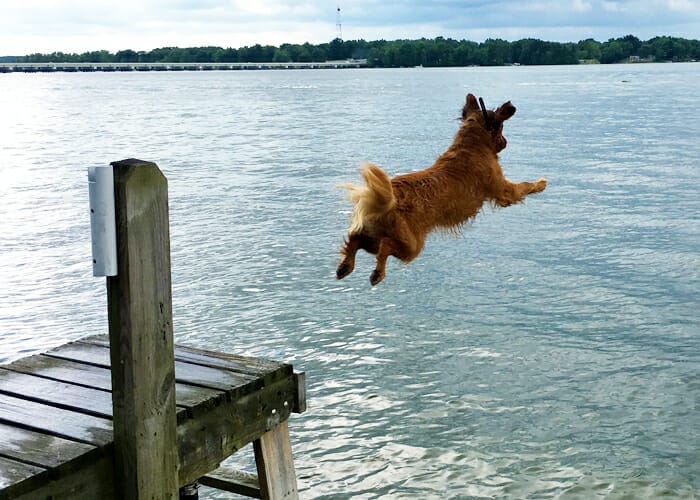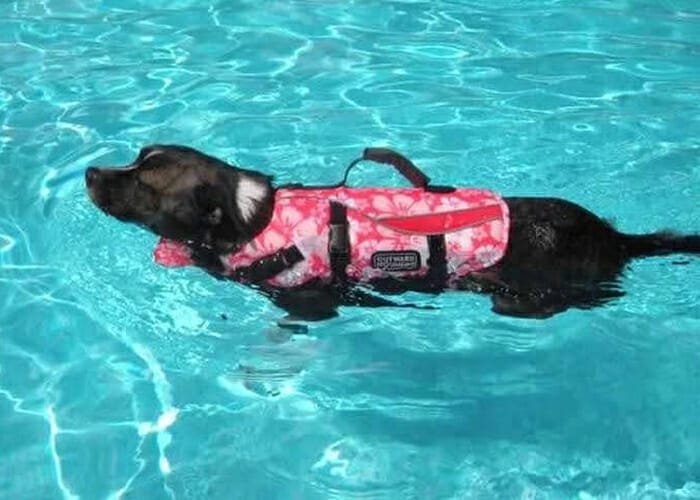Emergency Medicine, Urgent Care
Pet Water Safety: Staying Safe at the Pool, Beach, or Lake

Heading to the pool, beach, or lake sounds can be a wonderful form of exercise and can help your pet cool off on a hot day. You’ll just want to be mindful of water safety for your pet to make sure your trip to the water doesn’t end with a trip to the ER.
How to Safely Introduce Your Pet to the Water
Even though everyone has heard of the “doggy paddle,” our dogs don’t automatically know how to swim. It’s important to slowly introduce your pet to the water to get them comfortable. Just as you would for a child, you’ll need to help your pet learn to swim.
- Pick a shallow spot to start out and stay at the edge of the water. Allow them to play by chasing a ball or toy in shallow water.
- Don’t force them in. Throwing a pet in the water who doesn’t want to swim can be traumatic for them and keep them from wanting to get in the water again.
- Get in the water with them. When they start paddling with their front paws, lift their hind end so they understand how to float.
- Keep them on a leash at first so they can’t stray too far away from you.
- Make sure the water temperature isn’t too cold. Pets can get hypothermia just like you. If it’s too cold for you to be comfortable in the water, it’s probably too cold for your pet, too.
Keep in mind that not every pet likes to swim. Most cats do not like to be immersed in water, and certain breeds of dogs are better suited for water than others. Dogs with shorter snouts and those with larger bodies but short legs (like Pugs or Bulldogs) don’t fare as well in the water as other breeds. They may swim for survival but probably not for fun.
Protect your Pet from Drowning
Be vigilant with your pets around water, just like you would a child. The most important pet water safety precaution is your watchful eye. Most cats will steer clear of water on their own, but they could accidentally fall in. And even dogs that like to swim should not be left unattended around water.
- Give rests. Swimming can be very tiring so your pet needs breaks just like humans do. A tired pet is more likely to drown.
- Keep them close. They don’t know how to conserve energy and will just keep swimming until they are too tired. If this happens, you want to be nearby so you can get to them quickly.
- Learn how to give pet CPR. If you regularly have your pet around water, take time to learn this important lifesaving technique.
- Remember your own safety. A large dog that is panicking in the water could interfere with your swimming, especially those who are smaller or not strong swimmers. Make sure you are being safe before jumping in to grab a pet.
Even once your pet is out of the water, there can be risks if they have accidentally inhaled water. “Dry drowning” or “secondary drowning” is when pets get too much water in their lungs. This can impact them hours to even days after they’re out of the water. The water in the lungs can lead to inflammation, infections, and even death. Keep an eye on your pet for signs like lethargy, coughing or hacking, or difficulty breathing. This is especially important if your pet had a near drowning incident where you had to pull them from the water.
Invest in a Life Jacket for Your Pet
Life jackets are great for use when teaching your pet to swim. However, it’s always a good idea to use one for puppies, senior dogs, short leg/long body breeds, and if you’re heading out in a boat or in deep water.
A life jacket should be form fitting, just like for humans. You’ll want to measure around the base of their neck, around the widest part of their ribcage, and the length of the back (from the base of the tail to the neck). It should fit just below their neck, snuggly, but without restricting their breathing. You should be able to get two fingers between the vest and your pet.
When choosing a life vest, also look for ones with bright colors. This will help you keep an eye on your pet while they’re in the water. You’ll also want a vest with handles on the sides or the top which can help you more easily pull your pet out of the water.

Pet Water Safety at the Pool
A backyard pool is fun for your family, but it can present some other potential issues for your pet.
- Limit access. Be sure to put a fence around a pool so your pet cannot fall in or jump in on their own. You may also consider investing in a pool alarm that will alert you if the water is disturbed by your pet (or anyone else) falling in.
- Make it easy to exit. Your pet should be able to enter and exit the pool on their own. Pets cannot climb a ladder so you should have broad, slip-free steps or a ramp that are easy for your pet to step on. Practice showing them how to get out using the steps.
- Don’t drink the water. To your pet, the pool may look like a giant, refreshing bowl of water. But the chlorine and other chemicals can make them sick, even in small amounts. You should always have fresh water for your pet to drink.
- Watch the pool cover. Ensure the cover is completely off and secured out of the way so your pet cannot get trapped underneath it.
- Keep an eye on pool toys. These bright colored toys look like they were made just for your dog to play with. But if your dog loves to chew, they could easily ingest a piece of a plastic or foam toy that could get lodged in their throat, stomach, or digestive tract.
- Safely store pool chemicals. Be sure that you store your chemicals in a safe spot that your pet cannot access.

Pet Water Safety at the Beach or the Lake
There are some extra safety precautions you’ll want to consider if you’re spending time with your pet at the ocean or at a lake, pond, or river. What seems like a great playground for your pet could include some hidden dangers.
Water Quality
- Beware of algal blooms. It is not safe for your pet (or you) to be in the water if there are algal blooms. Red tides and blue-green algae are especially dangerous. Red tides can be caused by a variety of plantlike organisms and are usually found in salty coastal waters. They produce toxic chemicals that are in the water, marine life, and even can be released in the air. These can cause neurological issues as well as respiratory issues. Blue-green algae (cyanobacteria) is most often found in fresh water during warmer weather. The water may have a pea-green color or look slime covered. Contact with this toxic substance can lead to neurological issues, liver damage, or even death.
- Don’t drink the water. Natural bodies of water can have bacteria, algae, or parasites that can give your pet diseases. Ocean water is salty, and if your pet drinks too much of it, they can become dehydrated. In large quantities, they can get salt poisoning (hypernatremia) which can have neurological impacts. Always ensure you have fresh water for your pet to drink.
Surroundings
- Watch your surroundings. Fish (including jellyfish) or other creatures that have washed up onto the shore may look like a tasty treat to your dog but could contain bacteria or other parasites as well as the potential to sting or bite. You’ll also want to keep an eye out for broken shells that could be cutting hazards.
- Keep an eye on currents. Rip currents run parallel and perpendicular to the shoreline and can impact even the strongest swimmers. These strong currents can quickly carry a person or pet far from shore. These aren’t limited to the ocean. Rip currents can occur in any large body of water with breaking waves (like the Great Lakes). Try to stay in calmer water, away from big waves or boats that may be leaving large wakes.
- Beware of fishing areas. If someone is fishing, it can be difficult to see fishing line that could entangle your pet. Stray fishing hooks can puncture their skin. And make sure to keep curious pets away from the tackle box. Bait can be a tempting snack and all the small fishing gear can be intriguing for a pet who likes to chew. These small items could lead to a blockage if swallowed.

Don’t Let Sun, Sand, or Water Dampen Your Fun
There’s no reason your pet can’t join you for a water-filled outing if you keep these safety precautions in mind.
As you prep for your time outdoors, keep in mind your pet can get sunburned, too. This is especially important for hairless or thinner-haired pets. You’ll want to make sure to use a sunscreen formulated just for them. This is one time you should not share your sunscreen!
Once you wrap up your water adventure, rinse your pet off to remove any pool chemicals, salt water, or sand which can irritate their skin. Finally, be sure to dry their ears. Water in the ears is a perfect breeding ground for bacteria which can lead to ear infections.
If you’ve run into any of these water hazards or you believe your pet may be experiencing symptoms related to a recent adventure, be sure to contact your veterinarian or visit your nearest MedVet.